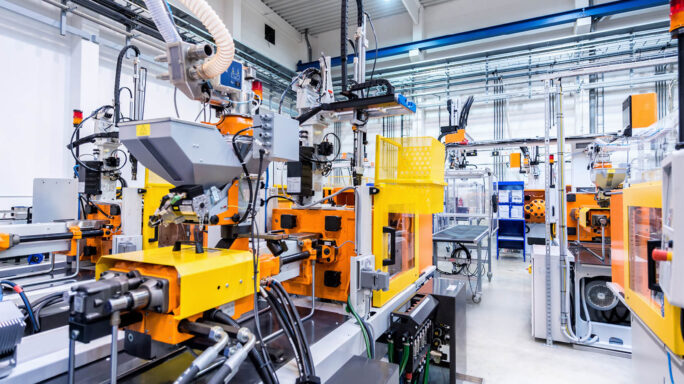Why embracing digital transformation is key for manufacturers
Medium-sized manufacturing firms must use digital transformation to become more efficient, reduce costs, create new models and stay competitive.

Did you know your manufacturing firm can use digital transformation to improve your processes and, in the process, help restore the UK’s position as a leading global manufacturer?
The scope is huge.
Digital technologies could add £455bn of value to UK manufacturing over 10 years, according to consulting firm Accenture and Made Smarter, with benefits available to companies of every size. They could also generate 175,000 jobs, increase industrial productivity by 25% and reduce carbon emissions by 4.5%.
Made Smarter started as a joint UK government and industry led review in 2017. This then kicked off a programme of initiatives aimed at driving productivity in the UK by accelerating digital technologies in manufacturing. Hundreds of organisations, including many small and medium-sized enterprises (SMEs), are taking part.
What is digital transformation?
Derek Cummings, director in the business performance improvement practice at consultant Protiviti, says that for manufacturers this involves looking across the value chain for ways to optimise the business using the value of data, and enabling information to flow in a way that supports rapid and effective decision-making.
Many medium-sized manufacturing firms are already using it to create so-called smart factories using technologies such as:
- Digital thread (frameworks that connect data flows)
- Artificial intelligence
- 3D printing
- Big data
- Big data analytics
- Robotics
- Robotic process automation (RPA)
- General ledger technology blockchain.
What are the benefits for manufacturers?
Manufacturers can use these technologies to increase efficiency, flexibility and transparency. It also aims to reduce lead times, inventory, quality problems, machine downtime and after-sales maintenance costs.
UK manufacturing has been lagging behind other sectors, such as retail, in terms of implementing new technology. But given how highly competitive the manufacturing sector is, with low barriers to entry, your manufacturing firm needs to embrace it to maintain competitiveness.
Cummings says that, unless a manufacturer has a unique product with intellectual property that cannot be replicated, failure to embrace digitisation will lead to an inability to compete and ultimate demise.
A clear strategy is essential
Graham Malley, principal director at Accenture, says a digitisation strategy for most medium-sized manufacturing companies involves using technologies to improve efficiency and reduce costs – or to develop new products and services.
Accenture research shows that 44% of companies pursue the former and 34% the latter – but only 13% currently achieve both.
Malley says companies that transform successfully tend to drive for six imperatives:
- Transform their core
- Innovate new business models
- Focus on experiences and outcomes
- Build a digital workforce
- Build new ecosystems
- Balance investment in the old and new.
Accenture research has also identified eight main barriers to industrial digitisation, with cyber security voted the top obstacle. The others were:
- Skills shortages
- Limited understanding
- Limited access to innovation
- Poor infrastructure
- Perceived cost
- Limited empirical evidence
- Existing legacy systems.
How to bring digital transformation into your manufacturing firm
“Many companies tend to pursue technology for technology’s sake and undertake many small scale pilot projects,” says Malley. “The best approach is to focus on a clear business need or problem.
“The approach should be rapid development – to create a ‘minimal viable product’. Then enhance that through operational experience and follow it with rapid scale.”
Derek Cummings at Protiviti says digital technology is versatile and businesses can deploy it in a wide variety of ways. But the trick, he adds, is to focus on transforming those aspects of the business that will have the most profound and significant impact.
Malley adds: “For example, a product manufacturer seeking a foothold in new international markets may focus on establishing a digital channel that supports product ordering, customisation and detailed tracking of product fulfilment from order to manufacture and dispatch.
“Meanwhile, a manufacturer supplying to a wide array of customers with complex payment terms could automate its collections activity to address working capital optimisation and speed up its order-to-cash cycle. This would reduce reliance on more expensive banking facilities to fund the operation of the business.”
Overcoming challenges
If your firm is looking to invest in digitisation, two major challenges you may face are access to funding and finding talent.
Any transformation needs a clear business case to attract funding, says Cummings. This should include a clear set of measurable objectives.
Once funded, your company also needs to make sure its vision is realised in implementation. To do this, you need to assign the realisation of objectives to a small set of individuals.
“Companies often do not recognise this as individuals become focused more on the ‘digital’ part of transformation,” says Cummings.
The next issue is talent.
“There is a hot market in digital talent, making it [a candidate’s market],” he adds.
“Manufacturers looking to apply the latest techniques in machine learning and predictive analytics, for example, are fighting for the same resources required by investment banks with much deeper pockets.”
One solution could be to partner with a recruitment firm who understands the local market and the firm’s objectives clearly.
Another challenge is that smaller organisations tend to have limited experience in this area and can easily get lost along the way if they establish a single “monolithic” transformation programme.
“Don’t be distracted by shiny new technology,” advises Cummings. “Focus on getting the basics right – identify and liberate the value in the data you already have.
“Deliver transformation one building block at a time by establishing a clear vision, supported by a multi-year road map.”
Smart factory revolution
A report from consultant PricewaterhouseCoopers has looked in more detail at smart factories, which it defines as having digital technologies that allow manufacturers to gather data from their operations, interpret it and predict with confidence events such as machine health and output levels.
Companies can make these insights available, selectively, to other members in their supply chain to enable instant tracking of goods, and bolster business confidence and resilience.
In its 2019 Annual Manufacturing Report, PwC found increasing awareness of the benefits of smart factories among UK manufacturers, with 74% accepting they will need to adopt digital technologies to prosper.
Most respondents see the biggest benefits in improving design and production processes (87%) or in streamlining internal company processes (74%). Meanwhile, 91% believe data from connected machines will improve decision-making and reduce costs.
PwC estimates that predictive maintenance can increase machine life by 20% to 40%, reduce machine downtime by 30% to 50%, and deliver 4% to 10% margin improvements.
But there is still a gap between awareness and investment and implementation. One in four respondents to the Annual Manufacturing Report having no digital plans, while 26% have it on the radar but are unsure how to implement it.
This trend is also reflected in the recent PwC Digital Operations Survey, which showed that UK manufacturers are growing their digital products and services at a lower rate than global competitors and therefore risk losing competitiveness.
The main barriers to digital investment appear to be:
- A lack of coherent digital strategies
- A lack of understanding about what practical applications these technologies offer.
For many organisations, the adoption of these technologies involves breaking traditional boundaries between the different functions; recruiting new skills; and transforming activities into more flexible, continuous processes.
If your firm is to capitalise on the benefits of smart factories, clear strategy and strong leadership from top management are vital, says PwC.
But the tide is turning.
This year’s Annual Manufacturing Report shows a growing understanding of the opportunities that digital technologies offer, from enabling staff to work smarter and be more engaged – to allowing businesses to serve customers more effectively and opening new markets.
The UK has a tremendous platform to capitalise on these technologies, but it needs to accelerate adoption, says the company.
Read more about manufacturing
- Why manufacturers need to invest in digital transformation
- 5 manufacturing goals to smash for business success
- Morven Burden: 8 top tips on running an effective manufacturing operation
- How servitisation can help manufacturers win more business
Digital transformation at UK manufacturing firms
Accenture has collected several short examples of how UK medium-sized companies have transformed themselves digitally:
- A fabrication plant with 50 shop floor operators used systems integration middleware to help recover more than 10,000 hours of lost production per year.
- A cut flower company with 60 full-time staff used robotic bunching to significantly improve packing efficiency, labour productivity and flexibility. The business has doubled its tulip crop in the past two years thanks to a positive reaction from customers and increased orders. Employment has also increased by 25%.
- A component manufacturer improved machine usage by 20% by introducing monitoring to provide real-time data on its manufacturing operations. This allowed more informed decisions in processing and planning. It also envisaged that factory floor optimisation would increase productivity by a further 30% in 18 months.
- Lastly, an engineering company introduced an Internet of Things system that improves communication between machines, resulting in a 20% reduction in component energy use.
How Crystal Doors embraced digital technology
Rochdale-based Crystal Doors ran a four-year transformation project starting in 2013, with three goals:
- Saving money
- Becoming more efficient
- Mining data.
The firm’s managing director, Richard Hagan, says: “I never accepted what is available in the market but saw a vision of what could be. Industry 4.0 [the fourth Industrial Revolution enabled by smart digital technologies] was in tune with my idea for a smart factory. This is all possible today.”
He says a major goal was to amass data that the company can interrogate, analyse and present in a clear way to enhance key performance indicators.
“We use Sage for accounting, which enables financial information regarding materials, fixed and variable overheads and employee costs – these are at the centre of all production,” says Hagan.
“As we seamlessly adopt this accounting software with Industry 4.0 to develop manufacturing efficiency, and with big data from the Internet of Things, it allows us to use artificial intelligence and algorithms to maximise capacity and production efficiency.”
To realise these goals, Crystal Doors needed a bespoke software package to process orders and improve efficiency in production planning and unit costs.
After designing its own software, the firm then integrated it with Sage Developer, the platform that allows companies to integrate in-house software with Sage Business Cloud.
“After capturing and integrating digital data at the manufacturing stage, Sage Developer delivers data seamlessly into the [bespoke] package,” explains Hagan. “This ability to deliver big data to customised software makes Sage a formidable accounting package. It allows us to see all production costs in real time.”
Crystal Doors makes more than 2,000 doors each week to specified sizes, designs and finishes. But it did not know how much to price each product before it was made. Extracting and manipulating data in real time allowed it to do this by making complex calculations in seconds.
The integration of in-house software allowed it to achieved clear profit margin calculations and much lower unit costs, says Hagan. Using third-party ordering and accounting software to achieve this would have been three times the cost and less flexible, he adds.
Although Crystal Doors’ transformation took four years in total, it started to deliver wins much more quickly.
“Within three months, we had software that delivered data from Sage for us to analyse, then back to Sage to create invoices, monthly statements and balances,” says Hagan. “Once we were confident of what data we could move, the real gems came from analysing big data from the factory floor and costs.
“In the early months, the access to core data was profound. We had years of data stored. Now Crystal Doors could exploit that data to drive efficiency and other improvements.”
No room for speculation
Another big challenge for medium-sized manufacturing firms is that they do not have the luxury of being able to run speculative projects, adds Hagan.
“[The transformation] must guarantee savings to pay for the outlay,” he says. “New technology, techniques and procedures are adopted slowly due to fear of losing money and profits. It’s natural to lack faith in something you don’t understand or can’t control.
“Crystal Doors therefore started our transformation with easy gains for small costs.
“The first three-month trial proved that the transformation was possible, then we carried out a larger feasibility study, and in the following six months, we created a program with all the capability we needed to process mass customised items. As the software developed, some ideas were too hard to achieve. But overall, we realised our vision.
“Digital transformation is a journey, and the first steps can be the hardest to take. When seen as one big step it can look impossible.
“But once the managers and employees saw the early success, they started to buy into their new technology. Now we can see the benefits on the bottom line, but also employees and owners have more transparency in the company’s financial success.
“This transparency also opens the door to a wealth of further improvements.”
Large corporations have adopted Industry 4.0. But those companies have many SMEs in their supply chain, says Hagan.
So for those SMEs, failing to adopt a digital transformation deprives you of the vital data that you need to interact with large customers. The technology that SMEs use must include big data captured by the Internet of Things, he says.
Hagan adds: “Data that is transferable in real time to customers, suppliers and within the company are essential foundations for working in the digital age. Crystal Doors could not operate without this transformation now. It has become a requirement, not a luxury.”
Tips to embrace digitisation for your manufacturing firm
Your vision can get lost if you view it simply as an IT project – it’s so much more than that. Here are some tips to help you along the way.
- The initiative must involve senior people across the business from the start.
- It must make individuals from each department responsible for realising the benefits of the project and set them measurable objectives from the start.
- You also need to encourage an innovative mindset, inspiring people to test out new things and allowing them to fail.
- Finally, do not be overwhelmed by the size of the task. Break it down into small, digestible chunks. Start out by looking for the small, easy wins that have maximum impact. These will convince the sceptics in your organisation and achieve the highest level of buy-in for the longer-term project.
The future of manufacturing
Hagan says the future of manufacturing will feature regular use of many technologies such as artificial intelligence (AI), virtual reality simulation, mass customisation, and rapid research and development.
“The introduction of [fifth-generation cellular network] 5G will be more than just an incremental change – it will enable huge transfers of data,” he says. “The future is with those companies that can harness that acceleration of data.
“Companies using simulation with virtual reality, or developing products using additive manufacturing will disrupt traditional methods. AI will play a huge part in data analysis. Digital information will be required to achieve carbon labelling on products to improve sustainability.
“Crystal Doors expects to use pattern matching using algorithms for production planning within the next few years. The company is also working towards online ordering of customisable items. Once paid for, the software platform, schedules, orders, supplies and production machines will start up without human intervention.
“Repetitive manufacturing tasks will be automated. Human contributions will migrate to development and analysis, checking quality and to maintaining machines.”
Accenture’s Graham Malley says technology breakthroughs in fields such as AI, robotics, and the Internet of Things are exciting. But those things working in concert will “turbo-charge” the impact in the future, he says.
“Industry 4.0 is evolving at an exponential rather than a linear pace,” adds Malley. “It heralds the transformation of entire systems of production, management and governance. Furthermore, new technologies such as 5G and quantum computing will continue to emerge. We are yet to witness their impact.”
As the Made Smarter Review says, accelerating adoption of these technologies could help your manufacturing firm, and others, recapture the UK’s industrial spirit as a nation of creators and makers.
The future of manufacturing
Want to grow your manufacturing firm and become more efficient at the same time? Learn how Industry 4.0 can help you achieve your goals.






